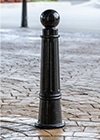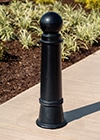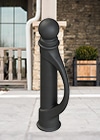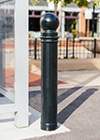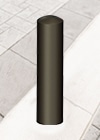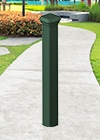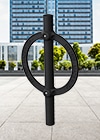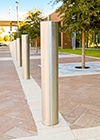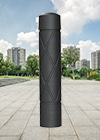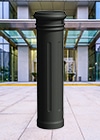Correct installation of bollards is one of the most important aspects of any streetscape or landscape project where these fixtures are included.
In fact, the only thing more important than getting them in the ground properly is making sure you’ve chosen the right ones. (Learn more about that here.)
Understanding installation matters because the time, complexity and cost associated with it can vary significantly depending on the product type you’ve chosen and whether it must serve protective as well as aesthetic purposes.
Keep reading to ensure these considerations don’t catch you off guard too late.
And for a deeper discussion on what to think about as you specify bollards, read our in-depth guide.
How function determines installation method
Your bollards’ role will be the most important determining factor in how the products are installed.
Installation requirements fall on a spectrum of difficulty and cost depending on:
- Whether bollards serve primarily aesthetic or protective purposes — or a blended multi-purpose role
- Whether bollards are permanently installed or designed for removability
Permanently installed bollards
Purely decorative bollards that need not offer any protective or deterrent value are the most straightforward and least costly to install. Often, surface mounting via some simple hardware and a masonry drill is sufficient. Engaging a concrete contractor is not strictly necessary for installing purely decorative bollards, although many buyers engage these professionals anyway. They make quick work of it.
It’s common that bollards serving a primarily architectural purpose still must offer some degree of protection. When this is the case, the bollard will need to be embedded within new or existing concrete. If protective bollards are installed in an area without concrete, a subsurface concrete foundation is still necessary for the bollard to perform its protective role. As such, installation is more complex and comes at a higher cost. A concrete contractor is definitely recommended.
Finally, the most complicated (and costly) installation is for bollards serving primarily protective purposes in venues where they must meet specific crash ratings. Owing to these more strenuous requirements, installation is much more complex. Installation locations must be prepared for the excavation and pouring of footings that, in some instances, can go as deep as four feet below ground level. Further, a civil engineer must sign their approval that bollards are crash rated. Concrete contractors are necessary to perform the installation.
Removable bollards
But how do installation considerations change when bollards — whether they’re protective or decorative or both — must be removable?
This is generally harder to accomplish so engaging the right concrete contractor is key. However, BollardsUSA has made things a bit simpler with our patented Twist & Lock removable bollard system.
Twist & Lock installation involves embedding a casting into new concrete which is engineered to accept the bollard design of your choice. Then, just like the name says, bollards are twisted to lock into place.
And if you’re worried that anyone could twist the fixtures out of the ground and walk off with them, our systems are designed such that they can only be removed via special anti-theft tooling.
Again, because installing Twist & Lock bollards involves embedding hardware in concrete, a concrete contractor is required. And if removable bollards must meet specific crash ratings, be prepared for a much more complex and strenuous installation process to ensure required engineer impact certifications are met.
Searching for inspiration? Aesthetic appeal, pedestrian delineation and removability all make an appearance in this case study from Huntingburg, Indiana. Removable bollards help transform the busy downtown into a safe, pedestrian-oriented gathering space for events and festivals.
Consider K4 mounts for unique protective applications
In some cases, buyers need bollards that offer crash-rated protection but site conditions prevent them from installing fixtures to the required depth below ground level.
There’s a way around that: shallow foundation mounting.
These bollard foundations are designed with a wider, shallower footprint and can be embedded roughly 12 inches below grade. This design spreads the energy of an impact laterally within a wider but lower-profile concrete slab rather than vertically through a very deep, narrow footing.

Site prep considerations
Bollards are installed under two basic project scenarios: either they’re incorporated into a newly planned landscape or construction project, or they’re incorporated as an additional element in an existing space.
It’s comparatively easy to install bollards in existing spaces without demolition or other significant site prep if the bollards do not need crash ratings. As noted earlier, it’s just a matter of drilling into the existing concrete of a sidewalk, roadside or plaza and setting the fixtures in place with the necessary materials and hardware.
More often, though, bollards are but one part of a larger new landscape or streetscape project. Site preparation is obviously more involved under those circumstances.
Take care not to let your bollards’ required degree of crash protection go overlooked in project planning.
To achieve a crash-rated foundation, you’ll need sufficient space either deep below grade or wide. Be sure your preconstruction survey reveals what, if anything, lies underground. Remember that some bollards must be mounted as deep as four feet below grade. If you don’t have enough room that far down, you’ll need to go shallower but wider.
For example, during recent work in Newark, New Jersey, the specification of K4/M30 shallow mountings helped project leaders achieve maximum crash protection without worrying about the tangle of subsurface utilities they were sure to encounter in a dense urban environment.
Does BollardsUSA install bollards?
BollardsUSA manufactures and ships bollards nationwide from our foundry in Middlesboro, Kentucky, but we do not install bollards on-site. We always recommend engaging a trusted local concrete contractor for that.
That’s one of the most common questions our team is asked. See answers to the others here.
Get a quote or consult for custom options
It takes just a couple clicks to receive a quote for bollards for your next project. Start here — it’s super easy to select the product, choose colors and add-ons and review installation options.
If your upcoming work requires a more customized approach, our designers are ready to lend a hand. Connect with one here or give us an old-fashioned phone call at 1-502-554-1178.
A real human in Kentucky will answer the phone.

